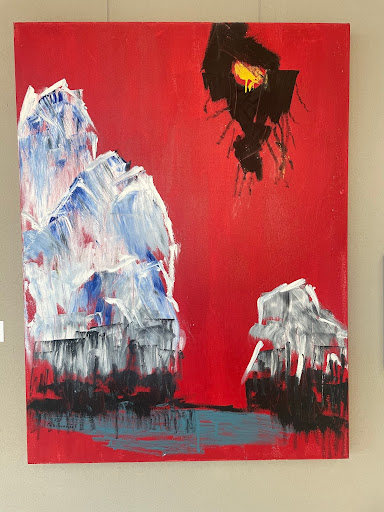Extending through May 31, the Wisconsin Institutes for Medical Research is hosting “Sight Beyond Limits,” a unique exhibition dedicated to displaying the artistic talents of those with visual impairments. The exhibition is co-sponsored by UW McPherson Eye Research Institute and ARTS for ALL Wisconsin and is being displayed in the ninth floor Mandelbaum & Albert Family Vision Gallery.
The gallery features works from eight different Wisconsin artists who have visual impairments. But what makes these works so special is they have been enriched and inspired by these impairments.
One of the artists is Albert Schmiege. Schmiege experiences poor depth perception, no central vision and color blindness due to Stargardt macular degeneration, according to biography in the gallery. Schmiege creates his art with bold colors, contrast and texture.
His piece titled “Global Warming” displays glaciers in hues of bright white and blue against a vibrant red backdrop. An ominous looking figure of jet black and yellow hovers above, suggesting an attack on the glaciers.
“My paintings are my passion and relaxation,” Schmiege said in his biography. “I can get lost in my work for three hours at a time. When people connect with a piece, it is the greatest feeling in the world!”
Another featured artist, Lynn Olson, works in several media including painting, illustration, woodworking and mosaics. Olson’s decades-long progression of eye disease has given her a rare opportunity to step away from her career promoting sustainable food and devote her life to her art.
Olson uses round pixels in her artwork to tell a story about her visual perception of the world, according to her biography. Her piece titled “Second Chances” displays these round pixels coming together in all different colors, forming a rainbow gradient of waves.
Artist Duncan Hamilton uses a Luxo lens lamp to magnify and illuminate his pastel drawings as he works, freeing him from the constraints of visual impairment.
“Those limitations disappear,” Hamilton said in his biography. “Then I’m free as a bird.”
Hamilton’s piece “Partial Acuity” uses a variety of light and dark blue pastels to portray a blurred and unclear view, conveying what a person with visual impairment might see. According to Hamilton’s biography, some of his works are direct representations of visual impairment and some pieces are free form.
Diagnosed with retinitis pigmentosa, Rosemarie Fortney has a field of vision limited to a five-degree central tunnel. Despite this, her creativity and talent flourishes and expands through photography and painting.
Some of Fortney’s photographs are captured within tunnel vision, such as her piece titled “Cyclamen 1.” In this piece, a photograph of a flower is encapsulated within a circle against a black background, representing her condition. She uses a circular tunnel-vision-like lens filter, which also highlights the depth, texture and tones of the blossom’s petals.
“Loss of vision need not dampen the creative life-force,” Fortney said in her biography. “Vision loss is a creative modifier in the art process.”
Schmiege, Olson, Hamilton and Fortney are only some of the artists on display in the gallery. Other artists include Beatrice Peyer, Alison Fortney, Ralph Curtis and Mark Weber, each of whom brings a unique perspective to art through the lens of visual impairment.
The Sight Beyond Limits exhibition will be on display from 8 a.m. to 5 p.m. Monday through Fridyay until the end of May.


